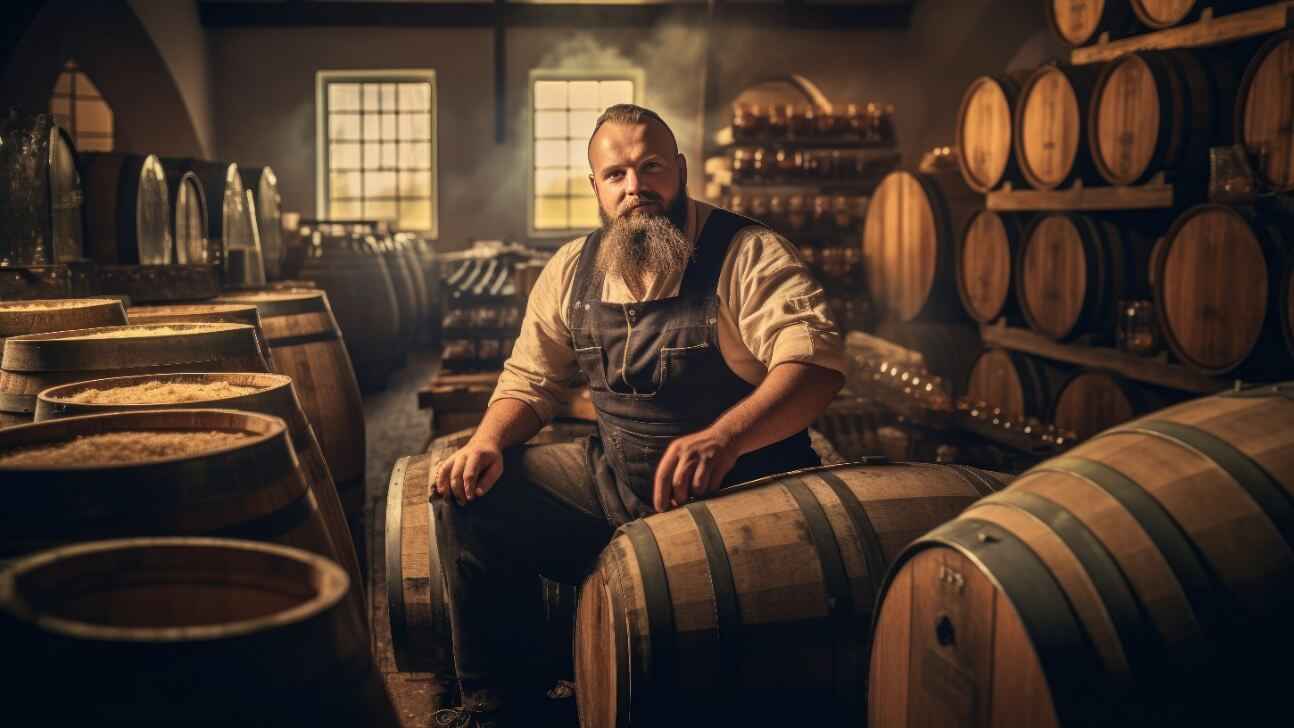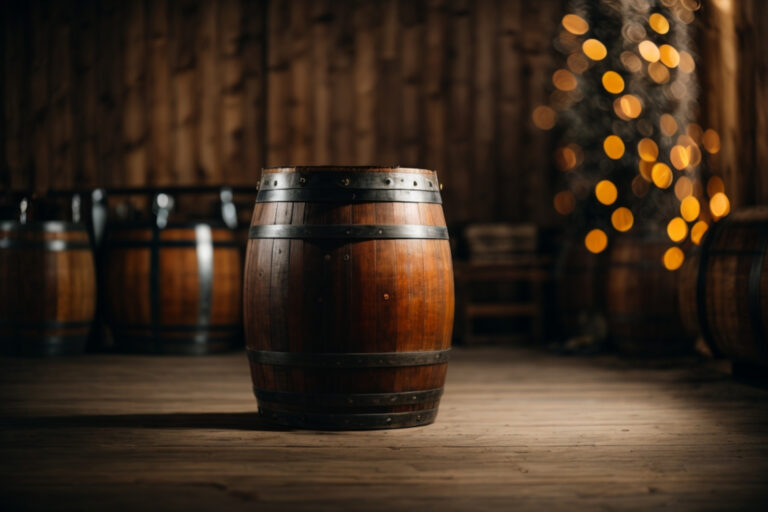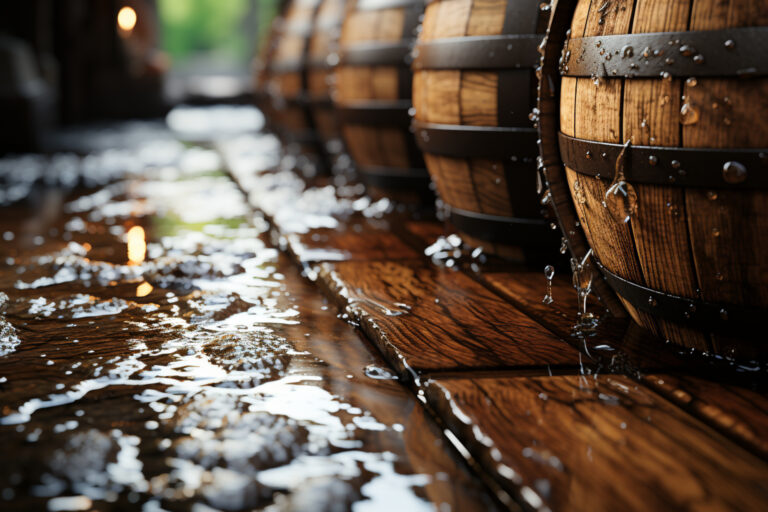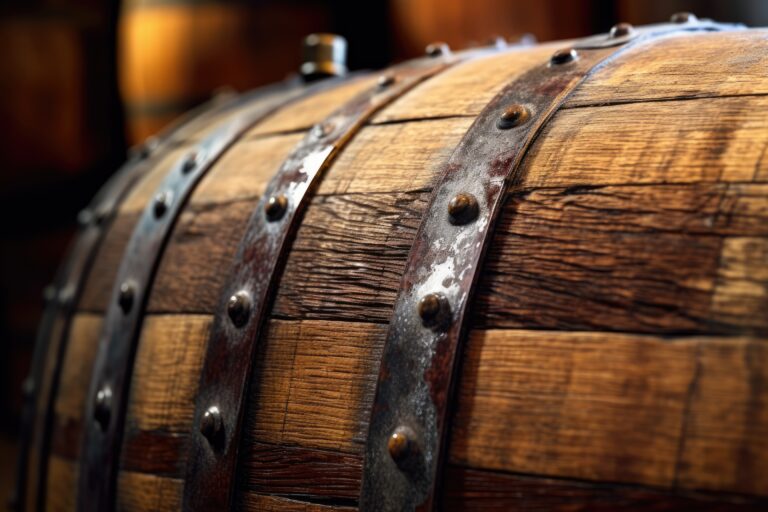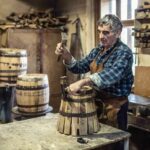Ever wondered how whiskey barrels can hold liquid for years without leaking? You’ve seen those charred oak barrels aging spirits like whiskey, brandy, or rum. They’re not exactly watertight, yet the precious cargo inside doesn’t spill out. What kind of woodworking magic is this?
Turns out, it’s not magic at all but simple wood science. The secret is in how the barrels are constructed and prepared. Wooden staves, the narrow planks that make up the barrel, expand and contract with changes in humidity. But when bound together into a barrel, the staves grip each other tightly, keeping the liquid in. The charring and toasting of the inside of the barrel helps too, creating a layer that further seals in the whiskey.
Yet oxygen still finds a way in. And this controlled interaction between spirit and air is what gives aged whiskey its distinctive color and flavors. Not too much oxidation, not too little. It’s a delicate balance achieved through natural wood chemistry and the art of the cooper, or barrel maker. Pretty clever for such an old technology!
So next time you sip an aged whiskey, brandy or rum, appreciate the craft behind those oak barrels. They may look simple, but they’re really small feats of engineering that have endured for centuries.
The Magic of Wooden Barrels for Aging Whiskey
The magic behind whiskey barrels is the wood itself. Oak barrels, usually American white oak or European oak, are porous enough to allow the whiskey to breathe, yet sturdy enough to hold the liquor without leaking.
As the whiskey ages in the wooden casks, the liquid soaks into the wood, extracting flavor compounds like vanillin as well as tannins that give aged whiskey its characteristic brown hue. At the same time, a small amount of oxygen enters the barrel through the wood, mellowing the whiskey. This oxygen exposure, along with the influence of the wood, transforms the sharp, harsh flavors of new whiskey into the smooth, complex taste of aged spirits.
The barrels also naturally contract and expand with changes in humidity and temperature, pumping the whiskey in and out of the wood. This constant movement helps speed up the aging process. The whiskey-soaked wood swells, sealing up cracks to prevent major leaks. Minor evaporation still occurs during aging, with the lost whiskey being affectionately referred to as the “angel’s share.”
After aging, most of the whiskey is transferred to bottles for sale, but some remains trapped within the wood. The barrel can then be used to age more whiskey, producing an even more complex spirit that incorporates flavors from the previous aging. And so, the magical cycle of wood and whiskey continues.
Understanding the Properties of Oak Wood
The secret to whiskey barrels not leaking lies in the properties of oak wood.
Oak is porous, meaning it has tiny holes that allow liquids and gasses to pass through. But oak also expands when wet, sealing up those pores. As spirits are aged in the barrels, the wood absorbs and releases portions of the liquid, exposing it to oxygen. This process, called oxidation, helps mellow and smooth the flavor of the whiskey.
The charred interior of the barrels also plays a role. The char layer contains carbon, which filters and mellows the whiskey. It also provides more surface area for the whiskey to interact with the wood. The aromatics and flavors from the wood and char are imparted to the spirit over time.
Temperature changes cause the wood to expand and contract, pushing the liquid in and out of the pores. This allows for oxidation and evaporation, which concentrates the flavor and color compounds in the remaining liquid. By the end of aging, nearly half the liquid can be lost to evaporation!
The marriage of spirit and wood over time results in the smooth, mellowed, and amber-colored whiskey we know and love. So raise your glass—the mighty oak has given us another gift to enjoy!
How Barrels Are Constructed to Be Watertight
Barrel makers construct casks to be watertight through a combination of wood selection, cooperage, and sealing.
Wood Selection
Barrel makers choose woods like oak that expand and contract with changes in moisture, sealing the barrel. Oak also imparts flavor to the whiskey.
Cooperage
Skilled coopers shape the staves, beveling their edges so they fit snugly together. They then heat the barrel, causing the wood to swell. Hoops are added to hold the barrel together as it cools and contracts, creating an airtight seal.
Sealing
Coopers seal any small gaps with a paste made of flour, water, and tree sap. As the barrel expands and contracts with temperature and humidity changes, the wood fibers swell to fill cracks while the hoops prevent the barrel from coming apart, keeping the contents safe inside.
A well-crafted barrel may last for several decades, all while imparting distinctive flavors to its contents. The combination of wood choice, cooperage skill, and natural sealing properties allows these simple yet elegant containers to stand the test of time.
The Swelling Effect of Whiskey on Barrel Staves
The aging process causes the staves (wooden planks) that make up the barrel to swell and expand. As the whiskey interacts with the wood, the liquor absorbs compounds from the wood, and the wood absorbs some of the whiskey. This interaction causes the wood to swell over time.
The steel hoops and bands that hold the barrel together allow for this expansion. They are adjustable and can be tightened as needed to account for the barrel’s increasing girth. The cooper (barrel maker) carefully crafts each barrel to have enough give for swelling but not so much that the barrel loses its shape or starts to leak.
Barrel swelling also creates an airtight seal as the staves press tightly against one another. This protects the whiskey from exposure to oxygen and helps the barrel retain the liquor during the aging process. The liquid-tight seal and slight barrel expansion are essential parts of creating the ideal environment for mellowing and maturing the whiskey.
Without this carefully controlled swelling effect, whiskey barrels would not properly age the spirit or be able to contain it for long. The marriage of wood and whiskey relies on the small expansions of the barrel over time to impart flavor and color to the liquor. Barrel making is truly an art form that Scottish and American coopers have perfected over centuries of practice.
Charring the Inside of Barrels
When whiskey barrels are first constructed, the insides are charred. The charring process involves burning the inside of the barrels, which caramelizes the wood sugars and forms a layer of charcoal. This charred layer impacts the flavor and color of the whiskey as it ages.
The charred wood adds smokey, toasted notes to the whiskey. It also turns the spirit a darker, amber color over time. In addition, the charred layer acts as a natural filter. As the whiskey expands and contracts during temperature changes, the charcoal layer helps remove undesirable compounds, resulting in a smoother spirit.
The level of charring can be customized for different flavor profiles. A lighter char, called toast, will add subtle wood notes. A medium char imparts more robust wood and caramel flavors. A heavy char, known as an alligator char, produces an even darker spirit with pronounced wood and smoke qualities.
Some distillers like to re-char casks between uses to renew the flavor effects. Others prefer used casks that have already mellowed to age their whiskey. In the end, the specific charring and cask management depends on the individual distiller and the style of whiskey they want to produce.
Natural Resins and Compounds in Oak
The natural resins and compounds in oak barrels play an important role in preventing leakage and imparting flavor to the whiskey.
Oak Lignin
Oak contains lignin, a complex organic polymer that acts as a natural sealant. As the barrel is charred during the barrel-making process, the lignin melts and fills in the pores of the wood. This creates an airtight seal, preventing the whiskey from leaking out of the barrel.
The lignin and other resinous compounds in oak wood, along with the charring process, give whiskey much of its distinctive flavor and aroma. The whiskey absorbs compounds like vanillin, lactones, tannins, and phenols as it ages in the barrel. This is what gives aged whiskey those familiar notes of vanilla, caramel, and spice.
The natural compounds in oak wood and the barrel charring technique have been used for centuries to produce many of the world’s finest brown spirits. By taking advantage of these natural resins and the chemical reactions that occur between the wood and the spirit during aging, distillers are able to create complex, multi-layered flavors that produce memorable drinking experiences.
So the next time you enjoy a glass of fine whiskey, you can appreciate the role that oak and barrel charring play in creating a spirit that does not leak one bit of its flavor. Salud!
Angels’ Share: The Evaporation Process
The process of angels’ share refers to the portion of whiskey that evaporates from the oak barrels during aging. Over time, the level of liquid in the barrels decreases as some of the alcohol evaporates. This typically amounts to about 2% of the total volume each year.
- As the whiskey interacts with the wood, the barrel allows for some evaporation and oxidation. This mellows the whiskey and gives it a darker color and smoother flavor. The loss of volume during aging is known as the angels’ share.
- The porous oak barrel allows for a small amount of evaporation and oxidation which helps create the complex flavors of aged whiskey. The conditions during aging like temperature, humidity, and air circulation all affect how much liquid is lost to evaporation.
- While barrel aging is essential for developing the distinctive taste of whiskey, too much angels’ share means less whiskey available to bottle and sell. Distillers aim to minimize loss from the angels’ share by using barrels with thicker staves, higher-quality wood, and controlling temperature and humidity during aging.
- The remaining liquid left after aging is bottled and sold as premium aged whiskey. Though distillers may lose a portion to the angels’ share during the aging process, what’s left in the barrel becomes a smooth, rich, and flavorful whiskey. The angels’ share is a necessary byproduct of creating an exceptional aged spirit.
Proper Care and Maintenance of Barrels
Proper barrel care and maintenance is key to ensuring your whiskey reaches its full potential. As a natural material, wood requires upkeep to prevent leaking and keep barrels in working order.
Cleaning
About once a month, thoroughly clean the exterior of barrels to remove built-up dirt and debris. Use warm water and a soft cloth or sponge to wipe down the outside. For stuck-on residue, you can make a paste from water and baking soda and gently scrub with an abrasive sponge or scrubber. Rinse well with water to remove any remaining paste.
Sealing
Check barrels regularly for any cracks or leaks in the wood. Minor cracks can often be sealed using beeswax, paraffin wax, or a commercial wood sealant and filler. For larger cracks or splits, you may need to patch and clamp the area before re-sealing.
Rotating
Rotate barrels every few months so the whiskey is exposed to different areas of the wood interior. This helps ensure even coloring and flavoring. Mark barrels with chalk or paint to keep track of rotation schedule.
Draining and Re-Filling
When a barrel is emptied after aging, don’t leave it sitting dry for long. As wood dries out, it can shrink and crack. Drain barrels and refill with new distillate as soon as possible. If unable to refill immediately, keep wood swollen by filling with water. Change water every few weeks until able to refill with whiskey.
Proper care and maintenance of your barrels helps produce better whiskey and extends the life of your casks. Keeping them clean, sealed, rotated and filled will reward you with a superior product in the end. What’s not to love about that?
FAQ: Common Questions About Whiskey Barrels
Why don’t whiskey barrels leak? This is a common question, given that barrels are made of wood and hold liquid for years. There are a few reasons why whiskey barrels are able to contain the spirits without leaking:
The wood expands when wet
When whiskey is first added to the barrel, the wood soaks it up, expanding the staves to seal the barrel. The wood swells tight against the steel hoops, preventing leaks.
The wood grains are aligned
Coopers carefully choose and align the wood grains to take advantage of the wood’s natural ability to swell and seal. The staves have vertical grains, while the heads have circular grains.
The barrel is carefully constructed
High-quality white oak is cut and shaped into staves that are beveled to fit tightly together. Skilled coopers raise and shape the staves with heat and water, then secure them with steel hoops. They ensure an airtight seal, especially at the heads.
The whiskey causes further expansion
Over time, the whiskey extracts compounds from the wood, causing the wood to expand even more. The barrel becomes watertight as it ages the whiskey. When emptied, barrels may require re-swelling with water before filling again.
Evaporation helps
A small amount of whiskey evaporates during aging, increasing the alcohol concentration. This evaporation also draws the wood staves even tighter together, strengthening the seal. The “angel’s share” that’s lost to evaporation helps ensure no whiskey is lost to leaks.
So while a barrel may seem simple, there are many complex interactions between the wood, whiskey, and environmental factors that allow it to perfectly age spirits without leaking a drop. The coopers’ craftsmanship, wood selection, and natural properties of oak all combine to make the whiskey barrel a liquid-tight container.
Final Thoughts
So there you have it, a few of the key reasons why whiskey barrels don’t leak despite years of aging booze. Oak’s tight grain, natural resins, and swelling abilities create an airtight seal as good as any modern-day container. The next time you’re sipping on a glass of aged whiskey, bourbon or rum, you can appreciate the craftsmanship behind those wooden barrels. Centuries of coopering experience, the careful selection of wood, and time-honored techniques all come together to ensure not a drop is wasted. Pretty amazing when you think about it. Wooden barrels may seem old-fashioned, but when it comes to aging spirits, there’s nothing quite like them.
